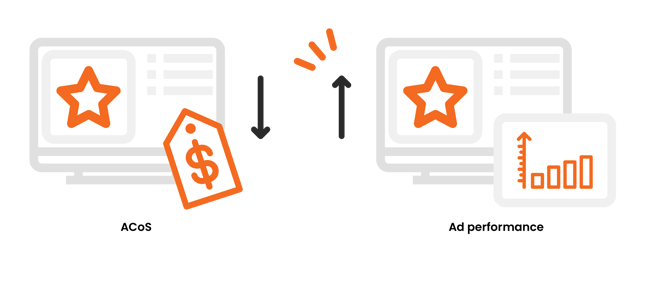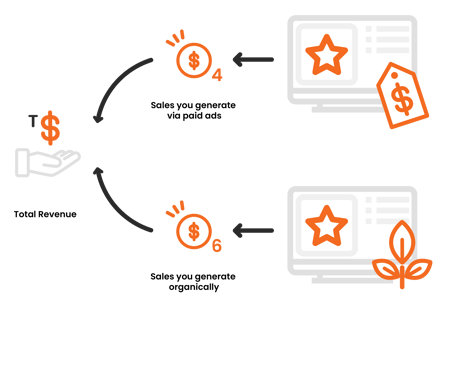Are you selling products on Amazon and would you like to do so more successfully? Then it is important that you have some knowledge of seller metrics on Amazon. Especially when you also want to start, run and optimize advertising campaigns, as you can benefit greatly from them. The various metrics give you insight into how well you are performing as a seller.
On this page, we will discuss the importance of Amazon Seller Metrics. We also give you more information about a number of specific metrics and their meaning. Finally, we'll give you a bit of knowledge on how to maintain an Amazon account.
Contents:
- Amazon Seller Metrics - why is it important?
- Amazon Advertising & Amazon Performance Metrics explained
- How do you keep track of your Seller Metrics?
Want advice on optimising your ads, or are you looking for someone to take this process off your hands? Brandsom has a lot of experience in setting up and implementing the right advertising strategy on Amazon. Want to know more? Click on the arrow below to get in touch with one of our marketplace consultants and request a no-obligation consultation.
Amazon Seller Metrics - why is it important?
It's impossible to be successful as a seller on Amazon if you don't know your metrics and don't know how your products or ads are running. In fact, the success or failure of your campaign says everything about your sales and marketing strategy. Read more on the different promotion options on Amazon in our Amazon promotions blog.
Especially if you are just starting out, the statistics can be a barrier. This is often the reason why entrepreneurs stop selling on Amazon. Yet, it is recommended to let the available statistics and data work for you, so you can find out what priorities you should set. The Amazon Seller metrics will help you see which products are running well and where there is still room for improvement.
Another reason to understand the metrics is that Amazon only allows good sellers on their platform. If you are selling products in a certain category on an ongoing basis - for example, health, electronics or clothing - you may continue to do so. If the campaign or sales are not successful, there is a chance that based on your Amazon Performance Metrics, Amazon will suspend your account for a certain category. At this stage, the platform looks at whether you can continue as a seller or not. Amazon would like you to actually sell products, rather than using the platform to generate reach.
Amazon Advertising & Amazon Performance Metrics explained
Keeping track of your Amazon Performance Metrics ensures the profitability of your Amazon account. If you do this on a daily basis, you will notice that you will sell more, thus achieving greater sales and ultimately making more profit.
Below we explain the various terms and abbreviations you'll encounter when getting started with Amazon Seller Metrics. We explain what the term means and how you can make Amazon PPC Metrics work for you.
Average Cost of Sale (ACoS)
For most advertisers, the ACoS is the most important variable of all Amazon Performance Metrics. The ACoS expresses how much advertising cost you incur per sale in percentages.
The lower the ACoS, the better the ad performance. Theoretically, an ACoS of 0 means that you spend nothing on advertising and still make sales. The importance of ACoS lies in its ability to show at a glance whether your ad is profitable or not.

Impressions
Impressions indicate how many times your ad has been displayed on the platform. If this variable is too low, your bid may be too low to run the ad. As a result, competitors are overbidding you. The best thing you can do is increase your bid.
Also, you may be using the wrong keywords for your target audience. The keywords are too specific, the selection of keywords is too small, and/or the words you are using do not match the search queries of your target audience. The best thing to do then is to change your keywords.
Clicks
Clicks indicate how many times people have clicked on your ad. When it comes to impressions and clicks, it is important to know two things:
- A high click rate with low sales indicates a problem on the product page. Your ad gets people to the product page, but something is causing them to click away from this page without buying anything. Most likely you are targeting your ad to the wrong people, or you need to improve your product page.
- A low click rate with many impressions indicates a problem with your targeting: many people view the ad but have no further interest in your product. This is due to a poor selection of keywords: the words you are using do not match the intent of the viewer of your ad. In this case, re-evaluate your keywords.
Click-Through Rate (CTR) on Amazon
The Click-Through Rate is the ratio of clicks on ads to the number of impressions. Of course, you want a high CTR, because that means viewers find your ad attractive enough to view your product page. Is this not the case? Improve your ad text, product image, keywords or the position of your ad. Or compare your ad with your competitors' ads to find out how to optimize it.
Total Spend
Total Spend is the total amount of advertising money you spend on your campaigns. To improve your profits, you should spend as little as possible on this variable. But if the spend is too low, there is a chance that Amazon will not show your ad enough. The platform will then not display your campaign. It is important also in this case to optimize your targeting and keywords. To improve your profits, you should find the sweet spot on the Total Spend variable; you should spend as little as possible but if the spend is too low, there is a chance that Amazon will not show your ad enough..png?width=452&name=TotalSpend-subtitles%20(1).png)
Total revenue
The total revenue is the sales you generate through organic and paid sales. Together they make up your total revenue. A healthy ratio between the two is 6:4. This means that of the sales, six were organic and four were paid for.
Cost per click (CPC)
CPC is the amount you spend once someone clicks on your ad. A product that you sell at a profit of 1 euro cannot afford a high CPC. This applies to your profit margin or the difference between the selling price and the advertising costs for this product. Don't set the ad price too high and don't price your product too low. Otherwise, selling on Amazon is not lucrative enough for you as a seller or brand owner.
Conversion rate
In short, the conversion rate is the number of sales after visitors view your product. This percentage ranges from 4 to 50%. Some market studies show that the average CVR on Amazon PPC is 9.6%, while for e-commerce it is 1.33%.
Amazon takes the conversion rate into account when determining the position of your ad, which in turn determines how often the ad is displayed.
How do you keep track of your Amazon Seller Metrics?
How you keep track of your metrics depends on the type of account you have. As an individual seller, you only have access to sales performance, payments, returns and tax documents. Professional sellers also have access to company and inventory reports. These reports are important for tracking traffic, inventory status and overall sales.
The Amazon Seller Metrics that tell more about the success of your Amazon webshop are:
- Order defect rate: These are the products that the customer returns due to a defect. It is a requirement of Amazon that the percentage of defective products is below 1%.
- Reviews: Positive reviews from buyers make your account grow and increase the position of your products in the feed.
- Cancellation rate: If you cancel more than 2.5% of orders before they are processed or confirmed as shipped, your account may be suspended.
- Late shipping rate: The requirement for this statistic is less than 4%; if more than 4% of your orders are not confirmed before the expected shipping date, your sales stats go downhill quickly.
- Valid tracking rate: Amazon cancels your account if more than 5% of your confirmed shipments do not have valid tracking numbers. Amazon considers a tracking code valid as soon as a courier scans it. Any tracking code that has never been scanned, for example, a cancelled order, will affect the score.
Need help with Amazon Seller Metrics?
Do you need help interpreting your Amazon Seller Metrics? Brandsom offers help with translating and tracking your metrics on Amazon to determine the best advertising strategy for your brand. Our ad specialists know everything about how to promote your brand on various marketplaces, including Amazon.
Find more information on our homepage, check out our service page or contact us at contact@brandsom.nl / 030-2270520 and request a no-obligation consultation.


